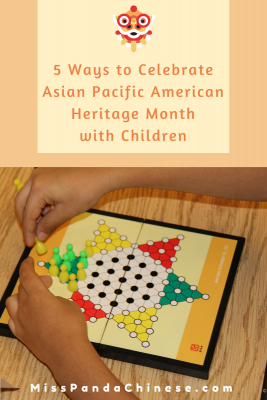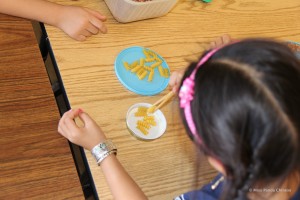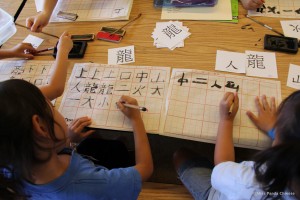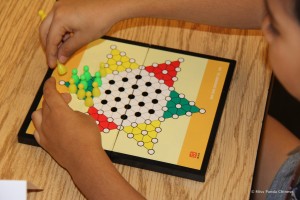May is Asian Pacific American Heritage Month – a celebration of the culture and history of Asian-Pacific Americans and Pacific Islanders in the United States. Asian Pacific American Heritage Month originated as a congressional bill in 1978 and in 1992 it was expanded from a week to a month-long celebration. This is a good time to learn something new about the diversity of Asian-Pacific cultures or to reflect on your culture with your child if you are descended from these groups. You and your children might also want to check out an interview with my son on learning his heritage language.

When I lived in Hawaii we celebrated many Asian cultures throughout the year. Asian Pacific American Heritage Month is around us not just in May. We watched mochi pounding demonstrations and tried out kimonos at the Ohana Festival at the Japanese Cultural Center. We enjoyed the acrobatic Dragon dance, Chinese crafts for kids, and various traditional lunar new year dishes during the three-week-long Chinese New Year festivities in town. Many people wore leis on Lei Day and its celebration included music, hula, and lei making. We felt the power of tae kwon do and sampled savory Korean cuisine like kimchi fried rice at the annual Korean Festival.
Hawaii is the proverbial “melting pot” and the schools there embrace the diversity of cultures. Children might cook a traditional Korean dish at school and bring home the recipe to share with the family. Kids go on field trips to the theater to watch plays adapted from traditional Japanese children’s stories. Hawaiian is a part of the school curriculum and some schools also offer other World Language Program languages such as Japanese and Chinese starting from kindergarten.
Video: Hop in and see what homemade dishes we enjoy!
The fun part about learning culture is that children can compare the differences in various aspects. When we see the differences in cultures we also identify some similarities in them. For the month of May, Asian Pacific American Heritage Month, you and your child can pick a country in the Asia-Pacific region and start exploring.
For my classes at the school, we pick China as our adventure destination. First, we start the program by finding Asia on the globe and we “fly” to different countries where the children’s parents or (great) grandparents are from. We spend some time listening to the children talking about the food they like from that country and the language they speak there. Then we “fly” to our final destination, China, and start our “Chinese Culture Experience Day!”
Below is a list of activities children enjoy. You can follow the ideas and expand to different countries and cultures you want to include in the game.
Story Time
Read together with your children. For the Chinese culture I have a few books to recommend:
Grandma Panda’s China Storybook – Interview with the author and illustrator, MingMei Yip.
All About China – Interview with the author, Allison Branscomb.
The Great Wall of Lucy Wu by Wendy Wan-Long Shang – A great read for children at upper grades and middle school+.
“Dim Sum for Everyone!” by Grace Lin introduces the little food dishes you might have seen on the carts in some Chinese restaurants and how families enjoy a Dim Sum meal together. The concluding pages provide the history of Dim Sum and the customs of having the meal.
“The Monkey King”, is a popular Chinese story for children that tells of the trickster Monkey King and his courageous journey to the West. Many of my students remark that the Monkey King and the Japanese story, Momotaro, which tells of a brave samurai born from a peach, are similar in some ways.
Music Fun
Here is a song every Chinese kid knows, Two Tigers! Roar and sing with me!
Watch a short video from Taipei Chinese Orchestra. Experience the sound of the Chinese Instruments.
Chopstick Challenge
People from China, Taiwan, Korea, Japan, and many Asian countries use chopsticks when they eat. How do you hold chopsticks? Can you pick up pasta, beans, and rice with chopsticks? Put out three trays with three different-sized grains and use chopsticks to pick them up into a bowl. I always add a bowl of easy-to-pick-up cereal for the kids. Children get a kick out of this activity and always want more snacks on the tray.
Write with a Chinese brush
Place the traditional inkpad, ink stone, and Chinese brush on the table and now we are going to write with a Chinese brush. The soft brush is very different from the pencils we use today. Children are always happy to know that modern Chinese children do not have to do their homework with a Chinese brush!
Chinese kids’ outdoor game
The “1-2-3 Wooden Men”(一二三木頭人|一二三木头人 – Yī’ èr sān mù tou rén) game is similar to “freeze tag.” The person who is “it” turns his back to the rest of the children who are lined up 10 or more feet away and says “yī’ èr sān mù tou rén” (literally “1, 2, 3 wooden men!”). When the person who is “it” is saying the sentence the kids behind him should run toward him. As soon as he or she finishes the sentence they turn around and check all the children to make sure they are all as still as a wooden man. Whoever moves at this time is sent back to the starting line. When the first person reaches “it” and touches him or her the game of tag starts. Whoever is tagged first then becomes “it” and the game starts over again.
Eat to Believe
The best way to enjoy a culture is to taste its food. Plan a family trip to one of the international markets near you. If you visit Chinatown you might find the ever-popular Bubble Tea from Taiwan, Dim Sum from Hong Kong, or Dumplings from Beijing. If you would like to try a simple Chinese dish at home here is an authentic Chinese Dumpling recipe from Grandma Panda, that is Miss Panda’s Mom. Enjoy! Furthermore, here is a recipe for the famous Green Onion Oil Pancake that everyone loves from Taiwan to the States, to Africa to South Africa. So, do give it a try!
Happy Asian-Pacific American Heritage Month! What country do you choose to explore? What is your biggest discovery? What is your child’s heritage language? Share with us!
Asian Pacific American Heritage Month Learning Resource:
HapaMama’s interview with Grace Lin, children’s writer, and illustrator on her latest book When the Sea Turned Silver
Bilingual map – Biculturalmama
Book: Beyond Two Worlds: A Taiwanese-American Adoptee’s Memoir & Search for Identity
Exploring Forbidden City, China
Discovering historical treasures with National Palace Museum, Taiwan
National Geographic Society: This Day in Geographic History
Learning about Asia with Kids
Taking a quiz on Asia!


